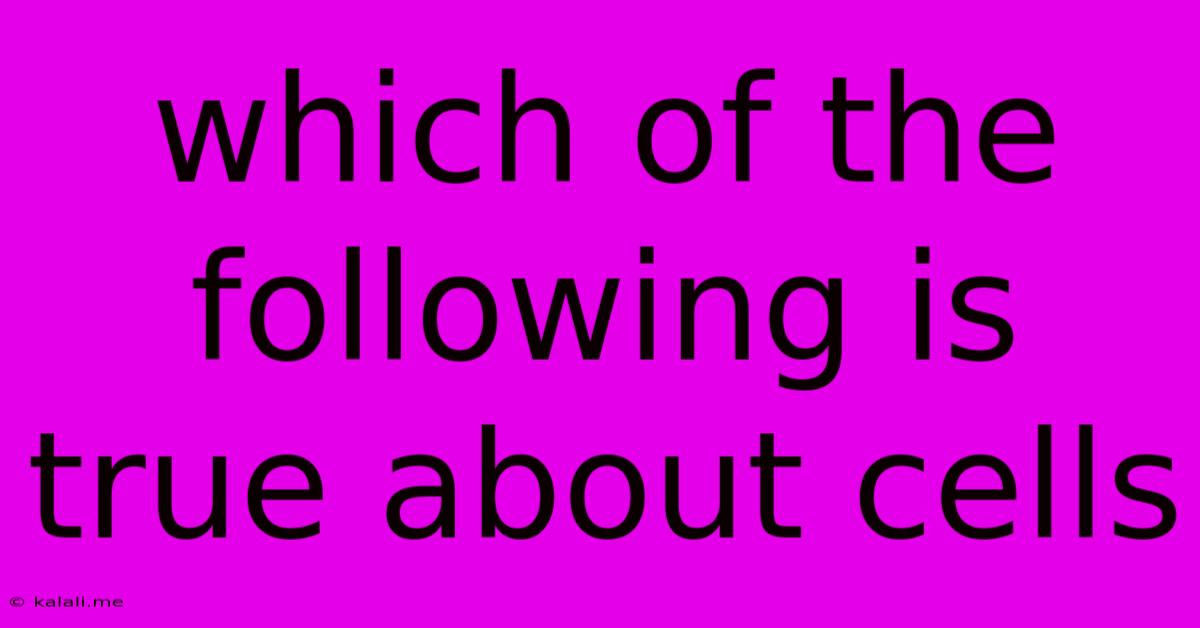Which Of The Following Is True About Cells
Kalali
Jun 13, 2025 · 3 min read

Table of Contents
Which of the following is true about cells? Deconstructing Cellular Biology
Cells are the fundamental building blocks of all living organisms, from the smallest bacteria to the largest whales. Understanding their characteristics is crucial to grasping the complexities of life itself. This article explores several common statements about cells and determines their truthfulness, providing a concise overview of cellular biology. This will help you understand the core tenets of cell theory and the diversity within the cellular world.
Key takeaway: Cells are incredibly diverse, yet share fundamental characteristics. This article will explore these commonalities and differences.
1. All cells contain a nucleus.
False. This statement is incorrect. While many cells possess a nucleus, a membrane-bound organelle housing the genetic material (DNA), a significant group of cells – prokaryotes (bacteria and archaea) – lack a nucleus. Their genetic material is located in a region called the nucleoid, which is not membrane-enclosed. Eukaryotic cells, on the other hand, including plant, animal, and fungal cells, do possess a nucleus. The presence or absence of a nucleus is a key distinction between these two broad categories of cells.
2. All cells have a cell membrane.
True. This is a fundamental characteristic shared by all cells, prokaryotic and eukaryotic alike. The cell membrane, also known as the plasma membrane, is a selectively permeable barrier that encloses the cell's contents, regulating the passage of substances in and out. It's composed primarily of a phospholipid bilayer and embedded proteins, crucial for maintaining the cell's internal environment and interacting with its surroundings. This membrane is essential for cellular homeostasis and survival.
3. All cells contain ribosomes.
True. Ribosomes are essential cellular structures responsible for protein synthesis. They are found in both prokaryotic and eukaryotic cells, though they differ slightly in size and structure. These tiny organelles translate the genetic code from messenger RNA (mRNA) into polypeptide chains, which fold into functional proteins. Protein synthesis is a fundamental process for all life, making ribosomes ubiquitous within the cellular world.
4. All cells undergo mitosis.
False. Mitosis is a type of cell division that results in two identical daughter cells. While it's a common process in eukaryotic cells for growth and repair, it's not universal. Prokaryotic cells reproduce asexually through a process called binary fission, which is fundamentally different from mitosis. Additionally, some eukaryotic cells, such as highly specialized cells like neurons, don't undergo mitosis in adulthood.
5. All cells contain mitochondria.
False. Mitochondria are often referred to as the "powerhouses" of the cell, generating ATP (adenosine triphosphate), the cell's primary energy currency. While present in most eukaryotic cells, there are exceptions. Certain single-celled eukaryotes that live in anaerobic environments lack mitochondria. Instead, they may rely on other mechanisms for energy production.
Conclusion: Understanding Cellular Diversity
The diversity of cells is vast, spanning a spectrum of sizes, shapes, and functionalities. While some fundamental characteristics, such as the presence of a cell membrane and ribosomes, are common to all cells, others, like the presence of a nucleus or mitochondria, vary depending on the cell type and its evolutionary history. Understanding these variations is crucial for appreciating the complexity and beauty of the biological world. Further exploration into cellular organelles, processes like meiosis and binary fission, and the evolution of different cell types will deepen this understanding.
Latest Posts
Latest Posts
-
San Diego State University Sat Requirements
Jun 14, 2025
-
Movement Of The Earth Around The Sun Is Called
Jun 14, 2025
-
Application For The Post Of Teacher
Jun 14, 2025
-
Which Of The Following Is A Nonrenewable Energy Resource
Jun 14, 2025
-
What Is The Square Root Of 0 09
Jun 14, 2025
Related Post
Thank you for visiting our website which covers about Which Of The Following Is True About Cells . We hope the information provided has been useful to you. Feel free to contact us if you have any questions or need further assistance. See you next time and don't miss to bookmark.